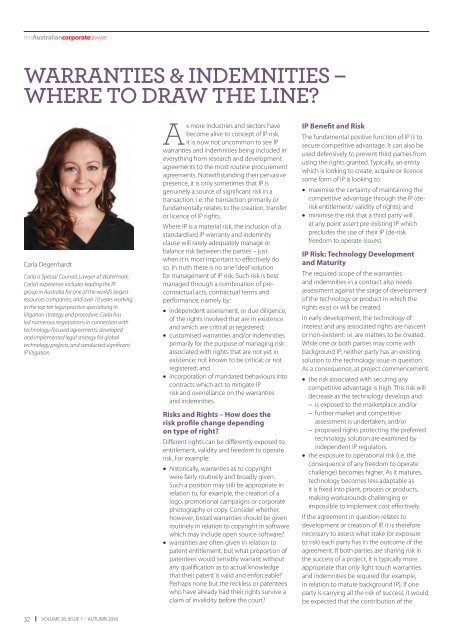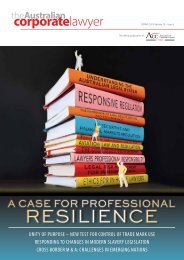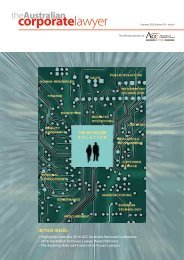Australian Corporate Lawyer - Autumn 2016
Australian Corporate Lawyer is the official publication of the Association of Corporate Counsel (ACC) Australia. The Autumn 2016 issue focuses on 'Advancing your in-House Career' and features a range of articles covering topics including: managing stress; trade marks and domain names; career motivated misconduct and cultural diversity.
Australian Corporate Lawyer is the official publication of the Association of Corporate Counsel (ACC) Australia. The Autumn 2016 issue focuses on 'Advancing your in-House Career' and features a range of articles covering topics including: managing stress; trade marks and domain names; career motivated misconduct and cultural diversity.
Create successful ePaper yourself
Turn your PDF publications into a flip-book with our unique Google optimized e-Paper software.
the<strong>Australian</strong>corporatelawyer<br />
WARRANTIES & INDEMNITIES –<br />
WHERE TO DRAW THE LINE?<br />
Carla Degenhardt<br />
Carla is Special Counsel, <strong>Lawyer</strong> at Watermark.<br />
Carla’s experience includes leading the IP<br />
group in Australia for one of the world’s largest<br />
resources companies, and over 10 years working<br />
in the top tier legal practice specialising in<br />
litigation strategy and procedure. Carla has<br />
led numerous negotiations in connection with<br />
technology-focused agreements; developed<br />
and implemented legal strategy for global<br />
technology projects; and conducted significant<br />
IP litigation.<br />
As more industries and sectors have<br />
become alive to concept of IP risk,<br />
it is now not uncommon to see IP<br />
warranties and indemnities being included in<br />
everything from research and development<br />
agreements to the most routine procurement<br />
agreements. Notwithstanding their pervasive<br />
presence, it is only sometimes that IP is<br />
genuinely a source of significant risk in a<br />
transaction, i.e. the transaction primarily or<br />
fundamentally relates to the creation, transfer<br />
or licence of IP rights.<br />
Where IP is a material risk, the inclusion of a<br />
standardised IP warranty and indemnity<br />
clause will rarely adequately manage or<br />
balance risk between the parties – just<br />
when it is most important to effectively do<br />
so. In truth there is no one ‘ideal’ solution<br />
for management of IP risk. Such risk is best<br />
managed through a combination of precontractual<br />
acts, contractual terms and<br />
performance, namely by:<br />
• independent assessment, or due diligence,<br />
of the rights involved that are in existence<br />
and which are critical or registered;<br />
• customised warranties and/or indemnities<br />
primarily for the purpose of managing risk<br />
associated with rights that are not yet in<br />
existence; not known to be critical; or not<br />
registered; and<br />
• incorporation of mandated behaviours into<br />
contracts which act to mitigate IP<br />
risk and overreliance on the warranties<br />
and indemnities.<br />
Risks and Rights – How does the<br />
risk profile change depending<br />
on type of right?<br />
Different rights can be differently exposed to<br />
entitlement, validity and freedom to operate<br />
risk. For example:<br />
• historically, warranties as to copyright<br />
were fairly routinely and broadly given.<br />
Such a position may still be appropriate in<br />
relation to, for example, the creation of a<br />
logo, promotional campaigns or corporate<br />
photography or copy. Consider whether,<br />
however, broad warranties should be given<br />
routinely in relation to copyright in software<br />
which may include open source software?<br />
• warranties are often given in relation to<br />
patent entitlement, but what proportion of<br />
patentees would sensibly warrant without<br />
any qualification as to actual knowledge<br />
that their patent is valid and enforceable?<br />
Perhaps none but the reckless or patentees<br />
who have already had their rights survive a<br />
claim of invalidity before the court?<br />
IP Benefit and Risk<br />
The fundamental positive function of IP is to<br />
secure competitive advantage. It can also be<br />
used defensively to prevent third parties from<br />
using the rights granted. Typically, an entity<br />
which is looking to create, acquire or licence<br />
some form of IP is looking to:<br />
• maximise the certainty of maintaining the<br />
competitive advantage through the IP (derisk<br />
entitlement/ validity of rights); and<br />
• minimise the risk that a third party will<br />
at any point assert pre-existing IP which<br />
precludes the use of their IP (de-risk<br />
freedom to operate issues).<br />
IP Risk: Technology Development<br />
and Maturity<br />
The required scope of the warranties<br />
and indemnities in a contract also needs<br />
assessment against the stage of development<br />
of the technology or product in which the<br />
rights exist or will be created.<br />
In early development, the technology of<br />
interest and any associated rights are nascent<br />
or non-existent: i.e. are matters to be created.<br />
While one or both parties may come with<br />
background IP, neither party has an existing<br />
solution to the technology issue in question.<br />
As a consequence, at project commencement:<br />
• the risk associated with securing any<br />
competitive advantage is high. This risk will<br />
decrease as the technology develops and:<br />
- is exposed to the marketplace and/or<br />
- further market and competitive<br />
assessment is undertaken; and/or<br />
- proposed rights protecting the preferred<br />
technology solution are examined by<br />
independent IP regulators.<br />
• the exposure to operational risk (i.e. the<br />
consequence of any freedom to operate<br />
challenge) becomes higher. As it matures,<br />
technology becomes less adaptable as<br />
it is fixed into plant, process or products,<br />
making workarounds challenging or<br />
impossible to implement cost effectively.<br />
If the agreement in question relates to<br />
development or creation of IP, it is therefore<br />
necessary to assess what stake (or exposure<br />
to risk) each party has in the outcome of the<br />
agreement. If both parties are sharing risk in<br />
the success of a project, it is typically more<br />
appropriate that only light touch warranties<br />
and indemnities be required (for example,<br />
in relation to mature background IP). If one<br />
party is carrying all the risk of success, it would<br />
be expected that the contribution of the<br />
32 VOLUME 26, ISSUE 1 – AUTUMN <strong>2016</strong>
















